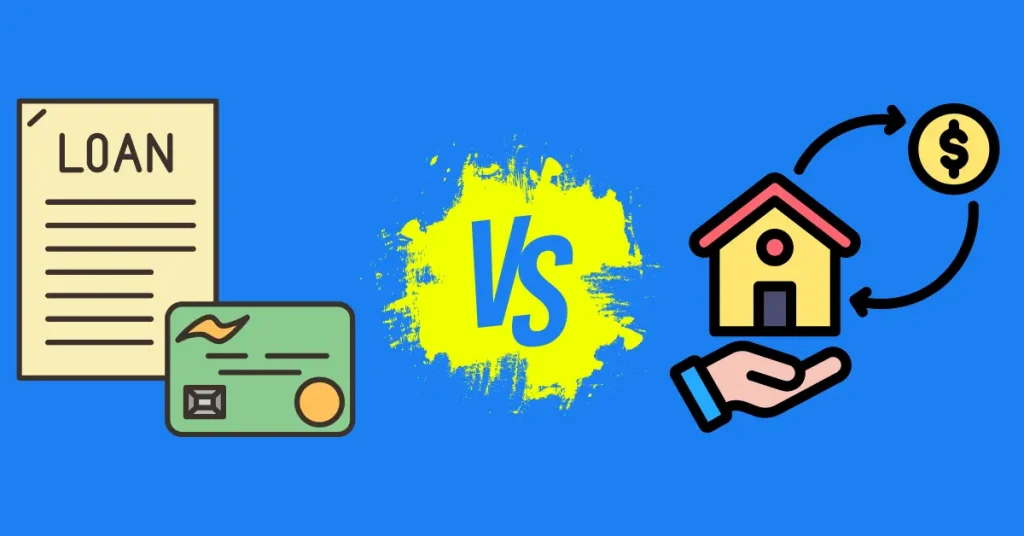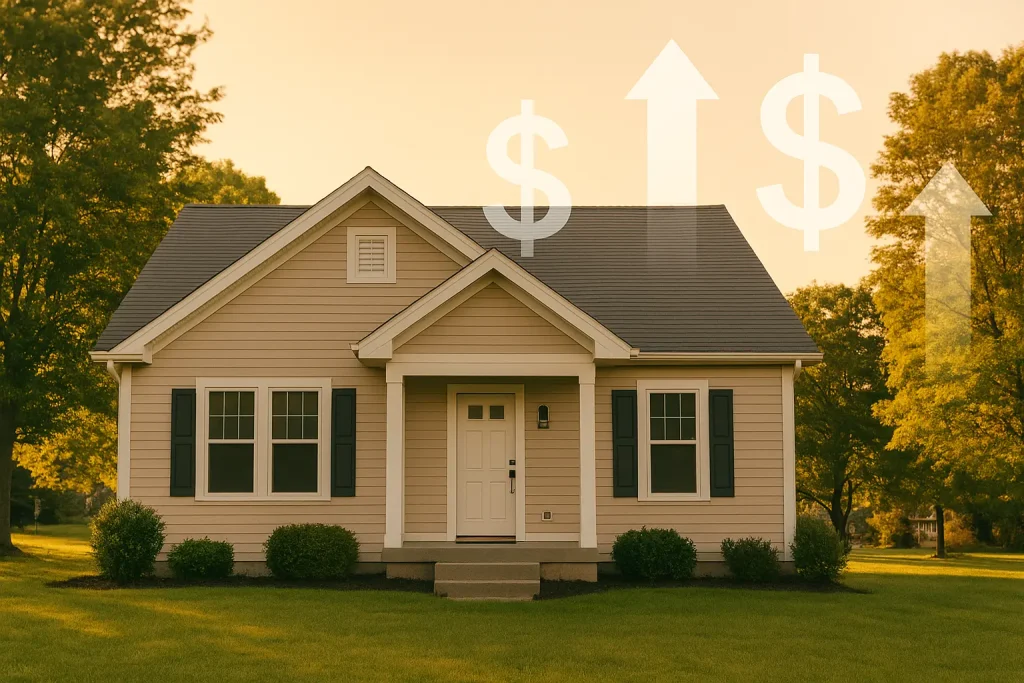A few years ago, locking in a three percent mortgage rate felt like hitting the jackpot.
Fast forward to today, and a lot of those same homeowners are sitting on record amounts of equity while trying to figure out how to use it. The kitchen needs an update. The credit cards keep growing. Or maybe there’s an opportunity to invest that you don’t want to miss.
hat’s where the confusion starts. You’ve heard of refinancing. You’ve heard of home equity loans. Both let you pull cash from your home, but they don’t work the same way. One keeps your low mortgage rate safe. The other replaces it completely. If you want a quick refresher on how home equity loans actually work, Bankrate offers a simple breakdown that explains what they are and when they make sense.
The question isn’t just how to access your equity. It’s which option actually saves you more money once rates, fees, and closing costs are all factored in.
If you want a deeper breakdown of how the wrong borrowing move can quietly eat into your equity, my guide on home equity walks through the most common ways homeowners end up paying more than they expected.
By the end of this guide, you’ll understand exactly when a home equity loan makes sense, when a refinance might be smarter, and how to decide which one protects your wallet best in 2025’s higher-rate world.
What’s the Core Difference Between a Home Equity Loan and a Refinance

Most homeowners know both options can unlock their home’s equity, but they work very differently. One adds a new loan, the other replaces your old one entirely.
Here’s the breakdown in plain English.
Home equity loan: A second loan secured by your home. It gives you a lump sum at a fixed interest rate, and you pay it back over a set term.
Refinance: Replaces your entire mortgage with a new one. That means a new rate, new term, and a new monthly payment.
Both pull from the same pool of equity, but the structure and long-term cost can be miles apart.
| Feature | Home Equity Loan | Refinance |
| Loan Type | Second mortgage | Replaces your first mortgage |
| Rate Type | Usually fixed | Fixed or variable |
| Funds Access | Lump sum | Based on total new loan amount |
| Best For | Keeping low first mortgage, funding renovations | Lowering rate or resetting loan term |
| Average Closing Costs | $0–$2,000 | $3,000–$6,000+ |
If you want a simple overview of how mortgage refinancing actually works, Fannie Mae’s refinance guide walks through what happens when you replace your loan and what to consider before making the switch.
When Each Option Makes Sense
Choosing between a home equity loan and a refinance isn’t about which one sounds better on paper. It’s about what actually fits your financial situation right now.
The right move depends on your mortgage rate, how much equity you’ve built, and how long you plan to stay in the home.
When a Home Equity Loan Wins

A home equity loan makes the most sense when you already have a low mortgage rate that you don’t want to lose.
Instead of replacing your entire loan, you’re simply adding a second one that borrows against your equity. This is ideal if you only need a smaller lump sum, somewhere between thirty and one hundred thousand dollars.
It also works well if you want predictable payments that never change. Since most home equity loans come with fixed rates, you’ll know exactly what you owe each month.
The best part is you don’t restart your thirty year clock. Your first mortgage keeps running on the same timeline while your new loan pays off separately.
This setup gives you flexibility without sacrificing your original low rate, which is especially valuable in today’s higher rate environment.
For a deeper look at how home equity loans work, Experian offers a straightforward breakdown of the pros, cons, and how they affect your credit and home value.
When a Refinance Makes More Sense
A refinance makes sense when your current interest rate is higher than what lenders are offering now.
This is the time to wipe out your old mortgage and replace it with one that has better terms. It’s also a smart option if you want the simplicity of one monthly payment instead of managing two separate loans.
A refinance can also free up major cash for big renovations or investment opportunities. Cash out refinancing lets you borrow more than you owe and pocket the difference, but it only pays off if you plan to stay in the home long term.
The longer you stay, the more time you have to recover closing costs and benefit from the lower rate.
The key is to think beyond the monthly payment and look at the total cost over time. That’s what separates a smart refinance from an expensive one.
Next, we’ll run through an example to show how both options stack up side by side so you can see exactly where the savings come from.
How Much You’ll Actually Pay (Real World Example)

Let’s put some real numbers on the table because this is where most homeowners finally see the difference.
Imagine you own a four hundred thousand dollar home. You still owe two hundred fifty thousand on your mortgage at a three percent rate, and you want fifty thousand for renovations.
You’ve got two ways to get that money.
Option A: Home Equity Loan at 9 Percent
This option keeps your existing mortgage completely intact.
You’d take out a separate fifty-thousand-dollar home equity loan at around nine percent. That adds about five hundred dollars a month in new payments.
Your original mortgage stays the same at roughly fifteen hundred a month.
That means your total monthly payment between both loans comes out to about two thousand dollars.
The upside is you keep your low three percent rate on the main loan, pay lower closing costs, and only borrow what you actually need.
Option B: Cash Out Refinance at 7 Percent on $300,000
his one replaces your original mortgage completely.
You’d refinance the entire loan into a new three-hundred-thousand-dollar mortgage at around seven percent. Your new single payment would land somewhere near two thousand dollars a month.
It sounds similar on paper, but now your entire balance is subject to a higher interest rate. You also lose that three percent loan and pay several thousand in closing costs upfront.
Scenario Overview:
| Home Equity Loan | Cash Out Refinance | |
| Existing Rate | 3% stays intact | Replaced with 7% |
| New Loan Amount | $50,000 | $300,000 |
| New Rate | 9% | 7% |
| Monthly Payment | $500 (new loan only) | $2,000 total |
| Total Monthly Payments | $2,000 | $2,000 |
| Closing Costs | $0–$2,000 | $3,000–$6,000+ |
| Long Term Effect | Keeps low rate, less total interest | Higher short term cost, may save later if rates drop |
Five Year Breakeven Example:
If rates stay flat, the home equity loan wins over five years with lower total interest and smaller upfront costs.
If rates drop significantly and you refinance again later, the full refinance might catch up — but that’s betting on timing the market, not guaranteed savings.
The takeaway here is simple. If your current rate is lower than what’s available today, protect it. Use a smaller, fixed home equity loan for short term cash instead of resetting your entire mortgage.
Costs, Fees, and Tax Implications
When you start comparing a home equity loan vs refinance, it’s easy to focus only on the rate. But the real cost of borrowing often hides in the fine print — the fees, the closing costs, and the tax implications that come later.
Home Equity Loan Fees
A home equity loan usually comes with lighter fees. You’ll likely pay for an appraisal, a small origination fee, and recording costs with your local county office. In most cases, total fees range from a few hundred to a couple thousand dollars. It’s cheaper upfront because you’re not replacing your entire mortgage, just adding a second one.
Refinance Fees
Refinancing is more expensive because it’s treated like starting a brand new mortgage. You’ll pay full closing costs again, which often include title fees, lender fees, credit checks, escrow setup, and legal recording. Depending on the loan size, expect to spend three to six thousand dollars or more before you ever make your first new payment.
Tax Angle
There’s one more thing to consider — the tax benefits. The IRS only allows you to deduct mortgage interest if the money is used to improve your home, not to pay off debt or cover other expenses.
If you want the official details, check out IRS Publication 936 on Home Mortgage Interest Deduction. It breaks down exactly when the interest from a home equity loan or refinance qualifies for a deduction and when it doesn’t.
Pros and Cons Summary

Every homeowner’s situation is different, but once you see the trade-offs side by side, the right choice usually becomes pretty clear.
Home Equity Loan
Pros:
- Keep your low first mortgage rate
- Fixed monthly payments you can easily budget for
- Lower closing costs and faster approval process
Cons:
- Adds a second monthly payment to your budget
- Usually comes with a higher interest rate than your main mortgage
- Smaller borrowing limits based on available equity
Refinance
Pros:
- Combines everything into one single payment
- May lower your rate if market conditions improve
- Resets your loan term for long-term financial planning
Cons:
- Replaces your old low rate with today’s higher one
- Comes with higher upfront closing costs
- Extends your payoff timeline if you start a new 30-year loan
Both options can make sense depending on what you need. The key is knowing whether you’re chasing flexibility or predictability — and how much those closing costs will actually eat into your savings.
Which One Saves You More Money?

So after all the math, which one actually saves you more money?
In most cases, it comes down to your current mortgage rate and how long you plan to stay in the home. The rest is just numbers on a spreadsheet.
If your mortgage rate is below five percent, a home equity loan almost always wins. It keeps your original rate locked in, adds a smaller second loan, and avoids those full refinance closing costs.
If your mortgage rate is above six percent, refinancing starts to make more sense. By replacing your old loan with a lower rate, you can save more in the long run — especially if you’re planning to stay put for several years.
And if rates fall again, you’ll always have the option to refinance later. Timing the market perfectly is impossible, but being smart with your equity today can keep thousands in your pocket down the road.
Quick Rule of Thumb:
Keep your low first mortgage. Borrow the smallest amount possible with a fixed rate home equity loan.
Home Equity Loan or Refinance: How to Decide What’s Right for You
Both a home equity loan and a refinance can be smart financial moves, just not at the same time or for the same reason.
A home equity loan protects your low first mortgage rate. A refinance resets the clock completely. One gives you flexibility, the other gives you a clean slate.
The right choice depends on your current mortgage rate, how much cash you need, and how long you plan to stay in the home. If you already scored a low rate, keep it. If you’re paying six percent or more, a refinance might finally make sense.
Either way, don’t guess. Run the numbers before calling lenders. Knowing your breakeven point and what the loan will truly cost over time will tell you which path actually saves you money.
The smartest homeowners aren’t the ones who jump first. They’re the ones who do the math before they move





